August 29th, 2025
Category: ar vr,Artificial Intelligence
No Comments
Posted by: Team TA

By generating incredibly realistic, interactive, and adaptable digital content, generative AI is transforming AR and VR. With AI-driven realistic environments, these technologies—which are already essential in gaming, education, entertainment, and healthcare—achieve greater immersion. Generative AI opens previously unheard-of possibilities and revolutionizes how people interact with the digital and real worlds as it blends with AR, VR, and the metaverse.
How does Generative AI shape the future of learning?
By providing personalized, versatile, and inclusive learning experiences, generative AI transforms AR and VR education. Acting as a virtual tutor, it creates dynamic content tailored to each student’s interests, pace, and knowledge level, ensuring lessons are always engaging and relevant. AI consistently evaluates progress in AR and VR, offering advanced challenges, additional practice, or real-time feedback as needed. This adaptable approach accelerates understanding, reduces boredom, and minimizes frustration.
Beyond customization, generative AI continuously enhances learning resources by analyzing how students interact and developing the most effective formats, whether they are audio, video, or interactive modules. It also improves accessibility by offering tools such as text-to-audio conversion and pace adjustments to support a diverse range of learners, including those with disabilities.
Ultimately, generative AI turns immersive learning into an adaptable, data-driven experience that encourages long-term success and deeper understanding by providing each student with appropriate support at the right time.
What impact is generative AI having on the production of 3D content for AR/VR experiences?
With the ability to create models, textures, and animations in minutes, generative AI is revolutionizing the creation of 3D content, reducing expenses, saving time, and minimizing its environmental impact. Rapid prototyping is made possible by platforms from NVIDIA, Roblox, and Unity, as well as tools like Unity Muse. This enables sectors such as entertainment and healthcare to undertake ambitious AR and VR projects that were previously considered impractical. With market demand projected to surpass $11 billion by 2032, Generative AI is redefining immersive development possibilities.
Is technology changing users’ expectations for interacting with digital interfaces, like virtual gaming?
Yes. Through generative AI, deeper interactivity and hyper-personalization are possible, revolutionizing virtual experiences. As demonstrated in Skyrim mods and games such as AI Dungeon, AI-driven NPCs in storytelling react organically to player input, producing dynamic narratives. AI personalizes user interactions in real-world contexts, such as digital concierges that remember user preferences and make customized recommendations, in addition to providing entertainment. Users can even create custom avatars instantly with platforms like Ready Player Me, which enhances the responsiveness and individuality of immersive worlds.
Explain how generative AI is transforming the AR/VR game development to deliver more immersive and dynamic experiences.
AR/VR game development is being revolutionized by generative AI, resulting in more dynamic, personalized, and immersive experiences. With AR, challenges are personalized based on local landmarks, events are updated in real time, and real-world surroundings are analyzed to place digital objects naturally. This guarantees that virtual components blend in perfectly with the real world.
In VR, artificial intelligence enables the creation of expansive, intricate worlds without the need for large budgets, dynamically modifies scenarios to increase replay value, and adapts gameplay to players’ feelings. Additionally, it makes collaborative tools possible that swiftly transform basic concepts into 3D scenes. AI creates dynamic environments and interactive events in multiplayer spaces, giving virtual worlds a sense of life.
When combined, these developments enable creators to create more immersive, flexible gaming experiences that integrate imagination and reality.
What are some of the ways that AI and AR/VR experiences have merged to transform various industries?
AI-powered AR/VR experiences are revolutionizing several industries by improving the effectiveness, personalization, and interactivity of experiences. Virtual fitting rooms in retail allow customers to try on clothing or makeup without physically visiting a store. In the classroom, students use realistic simulations that are customized to meet their learning objectives to investigate science, history, or medical procedures. Artificial intelligence develops more intelligent, lifelike characters and adaptable narratives, making gaming more engaging. AI-powered virtual reality in healthcare offers secure training environments for medical professionals and aids surgeons in visualizing data during procedures.
Which is better for AR and VR: traditional content creation or AI-generated content?
AI-generated content offers significant benefits to AR and VR, including quicker production, more lifelike graphics, and the easy scalability of huge virtual worlds. Nevertheless, it still needs quality checks, may lack human creativity, and may give rise to copyright issues. Although it is slower and requires more resources, traditional content creation offers uniqueness and artistic intuition. Combining the two is the most effective strategy; AI can manage speed and scale while human creators can direct creativity and guarantee meaningful, superior experiences.
Why is it challenging to implement AI in AR and VR from a technical standpoint?
Even though AI can greatly improve the immersion of AR and VR, it can be challenging to run advanced AI algorithms in real time. Due to their limited processing power, mobile headsets make it more difficult to complete tasks like object recognition and scene understanding. To prevent lag, these operations need to analyze vast amounts of visual data in milliseconds. Furthermore, gathering and processing the enormous volumes of training data required by AI models requires a substantial investment of time and resources.
Which innovative trends will influence AI in AR and VR in the future?
With mere text commands, generative AI makes it simple to create 3D worlds. Brain-computer interfaces allow users to manipulate their emotions and thoughts to control experiences. Real-time adaptation is made possible by machine learning, which modifies content according to user activity. Digital objects can be smoothly incorporated into physical spaces through spatial computing. In the future, physics-aware content, AI-moderated social hubs, and cross-reality storytelling will all be commonplace. These developments will make AR and VR experiences more intelligent, immersive, and customized than they have ever been.